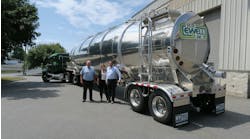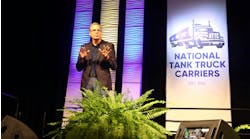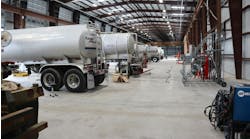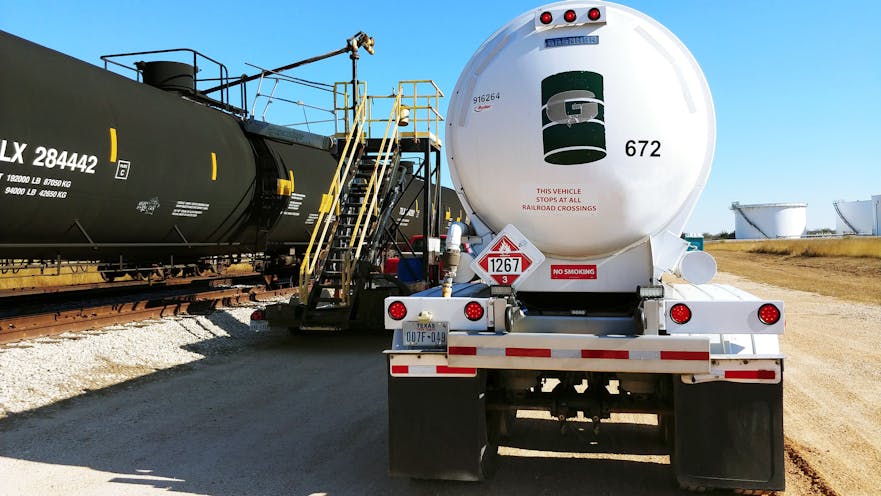GulfMark Energy president Greg Mills was in his new boss’ office when crude oil cratered.
On that infamous April 20, 2020, afternoon, U.S. crude oil prices went negative in the trading market for the first time in history, and the West Texas Intermediate (WTI) price eventually reached a previously unimagined minus $37.63 per barrel.
A gush of emotions flowed into a growing pit in his stomach as he and Kevin Roycraft, president and CEO of GulfMark parent Adams Resources & Energy, witnessed the freefall unfold on a TV in Roycraft’s office, but all Mills could do was laugh and, since it was 2020, take a few pictures with his phone for posterity.
“We’re watching it go down and down and down, and we’re actually snapping pictures, ‘OK, now it’s $7, now it’s $5—hey look it’s $1! This is a historic day,’” Mills recalled. “Then we saw it go to zero, and we didn’t know what was happening because what we were seeing didn’t reflect what was actually going on when it went negative.
“So he just looked at me and said, ‘Wow, you picked a great time to start with this company.’”
He’d been on the job less than three weeks.
“We didn’t blame Greg, but there was a lot of questioning,” quipped Dennis Bonner, GulfMark’s vice president of operations.
Fortunately for GulfMark, Mills had an answer.
His goal coming in was to help GulfMark’s oil marketing business better endure the frequent fluctuations in oil prices, and resulting inconsistency in revenue, by applying his 20 years of experience managing midstream energy assets.
He didn’t expect the need for a strategy shift to be demonstrated so dramatically.
“I (told Roycraft) maybe it’s exactly the right time to start with this company, because we’re going to get through it and pull it back together.”
Right time
That’s exactly what Roycraft wanted to hear.
The former president of fellow Adams subsidiary Service Transport Company had been in his new position less than three months when COVID-19 arrived in the United States, and the demand for crude oil plummeted.
Hiring Mills to replace longtime president Geoff Griffith was one of his first key moves.
“I wanted to bring in somebody who knows the industry but has a different view of it from an asset perspective, instead of just a marketing perspective, because if we can own assets and have the ability to market the product that goes in those assets, it opens more doors for us, and allows us to provide more services to our customer base,” Roycraft said.
Mills, a longtime Houston, Texas resident, has a background in midstream marketing, asset management and business development, having worked with natural gas liquids (NGLs), natural gas and crude oil. Prior to GulfMark, he spent two years as executive vice president of Energy Transfer’s commercial business in charge of crude oil assets; and 19 years with Enterprise Products in various roles, including VP of crude oil pipelines and terminals.
The Northeastern (Okla.) State graduate helped grow Enterprise’s crude business following its acquisition of TEPPCO Partners in 2009, focusing on long-haul pipelines to feed the Houston market, and Houston-area crude oil pipelines and storage terminals. At Energy Transfer, he championed the 2019 acquisition of SemGroup Corporation, which delivered critical connectivity from the company’s existing pipeline system to Cushing, Oklahoma, and Houston markets.
So it’s no surprise Mills’ first big move at GulfMark was another critical acquisition.
“I was hired by Adams to lead GulfMark in the development of assets to support the very strong marketing business we already have,” Mills said. “In my career, my primary role has been the development of new assets and expanding existing assets, to help the company expand their business revenues and profit.
“With GulfMark having the same goals in mind, my initial focus was the acquisition of the under-utilized Victoria Express Pipeline (VEX), and Cuero and Port of Victoria terminals. GulfMark has been the most active shipper on the system in the last year, and we have a strong book of crude oil business that surrounds the VEX assets.
“We were able to accomplish the purchase of this acquisition in October.”
Perfect pick-up
Mills said he and Roycraft initially discussed buying a gathering system. But Mills quickly realized the VEX was the asset GulfMark needed now. So discussions with previous owner EnLink Midstream Operating began in May, soon after he started at GulfMark. The companies signed a non-disclosure agreement later that month, and entered negotiations in June. “We spent a significant amount of time on the acquisition, conducting due diligence on the assets and negotiating the PSA (purchase and sale agreement) terms with EnLink,” Mills said.
“A number of GulfMark employees participated, and just about worked around the clock on the deal, until we closed on Oct. 22.”
The strategically located VEX crude oil and condensate pipeline system, which includes truck and storage terminals in Cuero and the Port of Victoria, Texas, connects the heart of the Eagle Ford Basin to Gulf Coast waterborne markets through 56 miles of 12-inch pipeline, spanning from DeWitt County to Victoria County.
The purchase agreement gave GulfMark an additional 350,000 barrels of above-ground storage, two eight-bay truck offload stations, and access to two docks at the Port of Victoria. The VEX system receives crude by pipeline and truck, and currently has downstream pipeline connections to two terminals, with potential for additional downstream connections. The system boasts a current capacity of 90,000 barrels per day.
“The VEX acquisition supports one of our key areas of focus—the Texas/Louisiana Gulf Coast—and gives GulfMark control of the VEX pipeline and terminal assets,” Mills said. “Ownership and control of VEX essentially allows GulfMark to improve the service to both our producer/operator customers, and our end-user markets (refineries).”
GulfMark acquired the VEX System for only $20 million ($10 million cash plus $10 million seller financing). EnLink reportedly purchased the VEX system from Devon Energy for around $220 million in 2015. Mills said GulfMark still was integrating VEX assets into its day-to-day business in December, but already utilizing the system in its Gulf Coast business while discussing further opportunities with existing and potential customers.
Operation’s origin
Kenneth Stanley “Bud” Adams is revered and reviled in Houston. He delivered the city its first professional football team, the Houston Oilers (now the Tennessee Titans), in 1960, then moved them to Tennessee in a bitter divorce in 1996.
But before his long career in sports, he made his fortune as an oilman.
Adams, whose father, K.S. “Boots” Adams, was a longtime president of Phillips Petroleum, founded wildcatting firm ADA Oil Company in 1947. ADA eventually grew into Adams Resources & Energy, which went public in 1974 and now is the parent company of GulfMark Energy and chemical hauler Service Transport Company.
GulfMark started as an oil marketing firm with no tangible assets in 1992 when Adams Resources, through its newly created GulfMark subsidiary, purchased the marketing business of GulfMark Energy I, Ltd, a partnership between Tri-C Resources and three individuals (Terry Tucker, George Wright and Jim Stewart). The business merged with ADA Crude, another Adams Resources subsidiary that was its first marketing and transportation unit, in 1998.
Bonner said GulfMark had about 40 trucks when he joined the company in 1999. It now boasts 190 tractors and 280 trailers.
Bud Adams also helped establish the culture that produced one of the country’s top oil marketing teams. He was using pro football players to help sell cars at his dealerships back in the 1960s. “He was a great marketer,” Bonner said.
Today, the marketing team’s relationships with oil producers and operators, along with the services the company provides, are key factors in its operational excellence.
Superior service
In the simplest terms, GulfMark buys crude oil, transports it and sells it.
It marketed 107,383 barrels per day (bpd) of crude oil in 2019, before the pandemic. It moved approximately 90,896 bpd during the third quarter of 2020, compared to 105,801 during the third quarter of 2019.
But the execution of GulfMark’s business is more complex.
The company operates in Texas, Louisiana, Oklahoma, North Dakota, Michigan and Ohio, with facilities or assets—including 243 total loading racks—in all but Ohio, and it boasts access to 4,100 diverse oil leases. GulfMark uses 15 storage terminal locations as pipeline injection points in the Gulf Coast, where it also has five barge terminals for deliveries to Houston, Corpus Christi and Beaumont.
GulfMark also sells to end users, including refiners or processors of oil, and delivers crude into two markets in Michigan, and a key pipeline in North Dakota; and it’s always tracking rig activity and new drilling permits in hopes of identifying new partners.
“Participation in different markets begins with our marketing team,” Mills said. “When they have relationships with producers, marketers and operators in a certain market, we have an opportunity to participate in that market. Our strategy is to add any necessary assets to support the business generated in these markets as we grow.”
A typical transaction starts with a contract with a producer set up by the marketing team. Then the company will dispatch one of its 250 truck drivers to pick up the crude oil, from the point of production in the oilfield or a storage location. Before accepting shipments, drivers must sample and test the oil to make sure it meets American Petroleum Institute (API) standards. If it checks out, they load up and finalize the purchase.
“It’s very important for our drivers, No. 1, to be trained and know what they’re doing, because they’re actually writing a check,” Bonner said. “But they’re also our customer service representatives, too, because we want the producers out there to feel like they got good service. So they have to do many things.”
GulfMark’s private, regional fleet primarily serves its customers. The only exception is in the Oklahoma/North Texas business unit, which hauls for another major crude oil buyer.
In addition to transportation, GulfMark provides financial services, including help with processing royalties and filing severance taxes. But the key to their business relationships, and continued success in a competitive industry, is a reputation for dependability and safety. Bonner said their transportation safety record is so outstanding, they were able to reduce their planned accrual for insurance expenses in 2020.
“GulfMark provides superior service to the operator, which many less efficient trucking companies cannot match,” Mills maintained. “We consider our transportation fleet and drivers best in class, especially with respect to our timeliness and ratability, safety metrics, and overall performance. (And our) financial services are … very beneficial to many small operators, and part of the reason why GulfMark retains business with many operators even in times of high volatility like we’ve seen in 2020.”
Equipment excellence
They retain drivers, and keep insurance premiums in check, with reliable equipment.
GulfMark’s tractors are a mix of Macks, Peterbilts and Freightliners. Its first Peterbilts and Freightliners were acquired in the 2018 purchase of crude oil transporter Red River Vehicle Holdings. The company only purchases new trucks with proven durability on rugged terrain.
With GulfMark trucks running on rutted oilfield roads and grass pastures, in addition to highways, the company can’t take chances on tractors with no track record.
“Our driver force is what makes our customer service great,” Mills said. “Keeping drivers is a big part of that. Drivers make their money hauling loads. If the equipment we give them does not allow that to happen, they will not stay long. This has been a key factor in our business model, and driver retention remains a huge focus with us.”
He initially was leery of deploying trucks with automated manual transmissions on oilfields, so they weren’t early adopters. Now he’s seen how they hold up—and help turn average drivers who struggled with manuals into expert off-road pilots.
The company’s newest Mack Pinnacle trucks are spec’d with its mDRIVE 12-speed automatic transmission, and Meritor air disc brakes all around. They also feature Mack’s Road Stability Advantage (RSA), Holland Compensator Series FW35 fifth wheels, Bendix antilock braking systems with traction control, Bendix Fusion 2.0 front and side collision avoidance warning systems, and heavier, 12,000- to 13,500-pound front axles.
Safety is further enhanced with factory-mounted LED lighting on the top and back of the cab, for drivers working around their trucks in low light, and idrive accident event recorder dash cameras. “Everyone in our company has a responsibility to work safe and has stop-work authority,” Mills said. “That comes from the top down, from the chairman of the board to the employee sweeping the floor, and we practice what we preach.”
Bonner said some drivers were wary of cameras early on, and a handful who couldn’t conform left. Now most recognize their value in safety, and in protecting them and the company in litigation. “Nowadays, drivers don’t want to drive a truck if the cameras aren’t working,” he said. “Same thing with electronic logs. They were leery at first, and now they can hardly stand manual logs. They think they’re being punished if they have to keep a manual log.”
Most trailers are 200-barrel, baffled DOT 407 aluminum tankers from Stevens and Brenner. GulfMark also runs Polars; and utilizes larger Dragon trailers in North Texas and Oklahoma, and Tremcar trailers in Michigan. Like the trucks, trailers are fully rigged out with safety lighting; and they feature VTRCORP’s TruckALERT vehicle deceleration warning lamps, which are similar to the pulsating rear lamps recently exempted by the Federal Motor Carrier Safety Administration (FMCSA) for use on tankers, except they’re decelerometer-controlled instead of brake-activated.
GulfMark owns 95% of its fleet but leases a few trucks “where it makes sense,” Mills said. It has maintenance facilities in Oklahoma and Texas, and benefits from access to Service Transport’s shops scattered across the U.S. GulfMark turns to Ryder where it doesn’t have shops or other service agreements.
Surviving 2020
Mills remained optimistic in the face of plummeting crude oil prices on the dreadful day in Roycraft’s office because he believes in GulfMark’s well-established business model, and proven ability to withstand market fluctuations.
And as far Roycraft is concerned, his optimism was justified.
Revenue is down—Adams reported revenues of $266.9 million for the third quarter of 2020, compared to $450.3 in the same period last year—but so are operating expenses, and Roycraft isn’t overly concerned with inventory valuations. “It doesn’t really matter what is the price of the oil that we have in our tanks,” he said. “We’ve already bought and sold the majority of it at a fixed margin.”
The second quarter of 2019—when crude went negative, refineries shut down and producers were storing oil they didn’t want to give away—was a challenge, Roycraft admitted. But as oil prices started to rebound, and producers ran out of space to store the oil, they started shipping again, and Adams saw demand return in Q3.
“We’re actually going to wind up finishing the year, between our two divisions, from a cash flow and income perspective, better than 2019, and if you would have told me that at the beginning of the second quarter, I would have said you’re crazy,” Roycraft said.
Mills is most proud of GulfMark’s ability to retain all its drivers—who are the company’s most essential workers—but acknowledges the coronavirus wreaked havoc on its business. “Crude oil is in new territory we’ve never seen before with this covid thing,” he said. “It’s a double black swan—we killed demand and then we killed supply. So we’re running, volume-wise, at roughly 50% of where we were a year ago on the Gulf Coast. We’re doing a little better up in Michigan, and hanging in there in North Dakota. And the company has been in the Permian, which is the big daddy right now, but because of the pipeline overbuild out of there, there’s really no margin, and no money to be made there right now.”
Still, GulfMark stayed in the black, he said, by leaning on long-standing relationships with operators and end users. “During 2020, with production dropping dramatically, and with much price volatility, GulfMark remained profitable by continuing to purchase crude oil from key customers we’ve taken care of for many years, selling crude oil to existing and new markets, and at the same time keeping our operating expenses in check by maintaining a firm grip on expenditures and improving our efficiency,” Mills insisted.
“For a year in which crude oil has seen huge fluctuations in value with the global pandemic, GulfMark has managed to navigate these really difficult times throughout the year and continue to perform well financially.”
Now, Mills said, refining margins on gasoline are recovering as people grow tired of staying home, especially overseas, jet fuel margins are rebounding, and rig counts are going up—all positive signs of recovery.
“As a company, we have learned that we can be nimble, and continue to successfully run our business even with many employees working from home,” Mills said. “And we have become much more tech savvy, utilizing various tools such as video conference, shared drives for reports and information management, and even chat tools to stay in touch when not in the same office, but working at our computers.”
Thriving in 2021
Remote working isn’t the only new normal created by COVID-19.
The coronavirus forced many financially insecure companies out of business, Mills said, so he expects to deal with a more consolidated industry going forward. He also sees the survivors providing a solid foundation for the future. “Regardless of some peoples’ views, we need crude oil,” he said. “We need NGLs, we need natural gas, for the next 20 years, and I wouldn’t want to be anywhere else than the Eagle Ford, even over the Permian.”
GulfMark and its parent are focused on several key initiatives in 2021.
Mills cites diversification of markets and further acquisition of assets with third-party revenue sources as critical goals. They’re also committed to continuing to grow the combined GulfMark-Service Transport fleet, while looking for new synergies that improve transportation efficiency and reduce operating expenses.
“Corporately, the idea of diversification is important, as Adams’ other subsidiary, Service Transport, is a bulk and chemical long-haul transportation company, which was affected by the covid virus at different times than GulfMark during the market slowdown,” Mills said. “For example, early in the downturn, as virus cases escalated, Service Transport saw additional business due to the impact of changes in market behavior, such as heavy demand for paint as people under quarantine fueled a surge in home improvement projects.”
GulfMark isn’t married only to crude oil either. Bonner said leaders always are looking for energy investments that make sense, even if that means moving into lithium mining, servicing wind farms or installing solar panels. “We’re very flexible on where we can go and what we can do,” Bonner explained. “We don’t have barriers to keep us from trying something if we think it’s feasible and profitable.”
Mills and Roycraft expect the VEX acquisition to continue to pay dividends. Mills said the goal is to bring in shippers who want to use the system to move oil across the pipeline and dock, creating a new revenue stream with built-in profit margins. Roycraft said the pipeline and terminals enable access to potential new customers, including companies like Max Midstream Texas, which is looking to establish a new overseas shipping export dock outside of Houston; while also giving them greater flexibility for an uncertain future.
“We still see a pretty long runway for crude even with the conversion over to electric or hydrogen vehicles,” Roycraft said. “We’re a long way from a significant amount of the over-the-road fleets being able to go that route. And production of these new-energy vehicles still requires hydrocarbons to build them. So there will still be a demand, and we’re well-positioned for that, especially with the services we provide to producers.
“At the same time, we’re always looking for what’s going to fit our fleets in the future, what’s coming down the road, and what is the next step for energy. The pipelines we’ve purchased can move other things later in life, and the tanks we have can store other products.”
In the meantime, Adams will continue to improve its fleets and operating systems. Roycraft said they already ordered 90 tractors—40 for GulfMark, 50 for Service Transport—for delivery in the first half of 2021; and GulfMark was slated to begin a full conversion to Trimble’s TMW.Suite transportation management software Jan. 1.
“By December 2021, we want to be about 95% of where we were in December 2019,” Mills said. “So we think it will get better and better each month. But it’s going to be a very different market. There have been nearly 50 bankruptcies of Houston-area oil producers, and more than that overall, so there’s a lot of consolidation going on.
“Where we really thrive, though, is with small producers and operators who need us, who we have relationships with, and trust us to be there to lift their oil before their tanks get full. The worst thing you can do is curtail production, so you have to be on time, you have to treat their property with respect, and you have to be safe doing it.”










